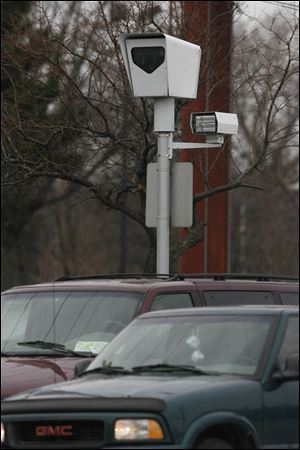
EDITORIAL
Keep the cameras
Traffic cameras must be properly regulated to prevent abuse, but they need not and should not be banned
6/10/2014
Toledo police officials say the city’s traffic cameras, such as this one, have reduced deaths in red-light crashes by nearly 40 percent.
Used properly, traffic cameras are valid and valuable law-enforcement tools. They identify many infractions — speeding, red-light running — and deter others. That makes streets safer and prevents deaths and serious injuries. The automated cameras at especially hazardous locations supplement the work of police officers who can’t be everywhere.
Used improperly, as primarily revenue-raising devices for local governments, traffic cameras can have pernicious effects. They have been the basis of virtual speed traps in several Ohio communities. That encourages public disrespect for the law.
It should be possible to develop and enforce guidelines that distinguish communities and police departments — such as Toledo, generally — that use traffic cameras appropriately from those that don’t. It hasn’t happened yet. But the often-advocated approach of prohibiting the cameras isn’t the answer.
The General Assembly went home for the summer last week without resolving the issue. But because it is sure to recur this fall — and because the Ohio Supreme Court is again examining the constitutionality of local laws that govern the use of traffic cameras — the process of developing standards needs to continue.
Traffic cameras are understandably unpopular among motorists who prefer to break the law with impunity. They resent getting citations in the mail after a camera detects their violations, and demand the “right” to argue their case at the scene with a traffic cop, however futile such appeals usually are.
Responding to such complaints, the state House passed a bill that would ban traffic cameras. A proposed Senate measure would require police departments to assign officers to the locations of cameras and write tickets for violations the cameras identify. That is effectively a ban as well, because few if any communities could afford such multimillion-dollar duplication of resources, especially at a time when state government has slashed the aid it gives local municipalities.
Such proposals go too far, and are especially curious coming from politicians who tout their tough-on-crime, law-and-order credentials on other issues. They also show little respect for home rule, to which state lawmakers also regularly pledge their devotion.
A separate Senate bill takes a more-enlightened approach: Instead of banning cameras, it would impose such statewide regulations as requiring police to review violations caught on camera before citations are sent, lengthening yellow lights at intersections where cameras are installed, and mandating traffic-safety studies before new cameras are placed.
These are all reasonable ideas. Still, local law-enforcement officials are in a better position to establish baseline safeguards than Statehouse politicians.
Ohio courts have slapped down communities that operated camera-assisted speed traps. Voters can fire the elected officials who promote such scams.
The state Supreme Court has declared traffic-camera regulation a matter of home rule. This week, the high court will review a Toledo case to determine whether the city’s administrative process for hearing appeals of traffic-camera citations offers adequate due-process protection.
Toledo Police Department officials say the city’s traffic cameras have reduced deaths in red-light crashes by nearly 40 percent. Reversing that progress by banning the cameras is too high a price to pay to satisfy a self-asserted right to drive recklessly in the name of libertarianism.
In the meantime, there’s a reliable way to avoid traffic tickets, from cameras or cops: Obey the law.